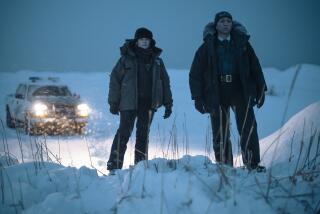MOVIE REVIEW : Clearly a Ready, Willing and Able ‘Danger’ : Harrison Ford Thriller Is the Best Clancy Film Yet, Notable for Its Plot and Character Nuances
- Share via
“Clear and Present Danger” does more than provide the summer’s most satisfying movie experience--which may sound like damning with faint praise, but shouldn’t. It reaffirms, if reaffirmation is necessary, Harrison Ford’s position as the most thankfully reliable action star around.
With those other big-ticket, big-muscle performers (you know who they are), it’s not known until it’s too late whether they’ve made a feast or a fiasco. Ford, by contrast, in searching for an emotional connection even in the brawniest of projects, has become as earnestly dependable as the characters he plays.
In fact, since “The Empire Strikes Back” in 1980, the actor has been the equivalent of a Good Housekeeping seal for the adventure genre, his presence guaranteeing an enviable level of professionalism, excitement and involvement in the thrillers, from “Witness” to “The Fugitive,” that he has appeared in.
“Clear and Present Danger” is the third Tom Clancy novel about CIA analyst Jack Ryan to be adapted to the screen, and the second time Ford, director Phillip Noyce, cinematographer Donald M. McAlpine and other key members of the cast and crew have been involved, and the practice has been good for everyone. This is easily the best and most tightly wound of the Clancy films, notable for the intricacy of its plot and the nuances its actors bring to characterization.
Initial credit for this must go to “Danger’s” jerry-built but effective script. Three very different writers--Clancy adaptation veteran Donald Stewart, character-sensitive Steven Zaillian (“Schindler’s List”) and action aficionado John Milius--share screen credit, and against all expectation the intelligent result is much closer to synergy than chaos.
If “Danger” does have a problem, it is that it starts too slowly. Partially this is a situation endemic to sequels, where all the familiar subsidiary faces, here including Anne Archer as Ryan’s wife, Cathy, and James Earl Jones as his boss, Adm. James Greer, have to be laboriously reintroduced to a perhaps forgetful audience.
The plot too begins tentatively with a pair of almost simultaneous actions. Ryan is unexpectedly thrust into a more active role in the intelligence bureaucracy, with new responsibilities that include testifying before Congress and even briefing the President. And the first situation he has to deal with is the murder at sea of a lifelong friend and political supporter of the chief executive.
When Ryan traces the murders to the infamous Cali Colombia drug cartel, President Edward Bennett (Donald Moffat) is incensed. “Drugs pouring into the country and the drug dealers think we’re powerless,” he fumes to National Security Adviser James Cutter (Harris Yulin). Isn’t it likely, he goes on, that the cartel represents “a clear and present danger to the national security of the United States,” a situation that allows for the commitment of American military power?
Though the expected thing for “Danger” to do at this point is break down into a U.S. versus the drug lords scenario, what happens is more subtle. There turns out to be not one Colombian adversary but several, not necessarily on good terms with each other. And far from a single monolithic American presence, there are various power centers with different perspectives and antithetical agendas.
What results is a pleasantly complex story line in which these numerous strands, both in Washington and Colombia, twist and turn as they combine and recombine in unexpected ways. This classic wheels-within-wheels situation makes each succeeding scene in the film just a little bit more tense than the one that came before.
Keeping this complexity involving and fast-moving is director Noyce, assisted by the adroit cross cutting of editor Neil Travis, who also handles the rapid shifting of scenes between numerous South American locations (all apparently photographed in Mexico). The action-set pieces are crackerjack as well, especially a complex ambush filmed on a two-football-fields-long set nicknamed “The Kill Zone” that required eight full weeks of preparation.
What is rarer than good action is plausible dialogue and acting, and this is “Danger’s” key strength. Especially convincing, and especially timely, is the film’s depiction of how covert operations go down in Washington, how ambitious men operate in a world of suggestion and innuendo, and how an ambiguous “the course of action I’d suggest is a course of action I can’t suggest” can set all sorts of mayhem into motion.
Not only are the key subsidiary characters written in a subtle way, “Danger” has cast the parts with unusually capable actors. In this country, Donald Moffat makes a most convincing President, alternately affable and arrogant, and Henry Czerny and Harris Yulin are equally good as White House apparatchiks.
In Colombia, Willem Dafoe is an appropriately cool CIA field operative, and Portuguese actor Joaquim de Almedia makes a clever and devious opponent. Even smaller roles, such as Ann Magnuson as an FBI secretary and veteran Hope Lange as a suspicious senator, are perfectly carried out.
And once again, as in so many films in the past, Harrison Ford and his combination of intensity and integrity hold it all together. Capable of bringing to life and sympathy a character derided as “a damn Boy Scout” by his more cynical adversaries, Ford is an actor who believes his word to the audience is a bond guaranteeing the best he has to give. Would there were more like him around.
* MPAA rating: PG-13 for “some intense action/violence and some language.” Times guidelines: Its body count is high, but the blood is under control.
‘Clear and Present Danger’
Harrison Ford: Jack Ryan Willem Dafoe: Clark Anne Archer: Cathy Ryan James Earl Jones: Admiral James Greer Joaquim de Almedia: Felix Cortez Henry Czerny: Robert Ritter Harris Yulin: James Cutter A Mace Neufeld and Robert Rehme production, released by Paramount Pictures. Director Phillip Noyce. Producers Mace Neufeld, Robert Rehme. Screenplay Donald Stewart and Steven Zaillian and John Milius, based on the novel by Tom Clancy. Cinematographer Donald M. McAlpine. Editor Neil Travis. Costumes Bernie Pollack. Music James Horner. Production design Terence Marsh. Running time: 2 hours, 23 minutes.
* In general release throughout Southern California.
More to Read
Only good movies
Get the Indie Focus newsletter, Mark Olsen's weekly guide to the world of cinema.
You may occasionally receive promotional content from the Los Angeles Times.











